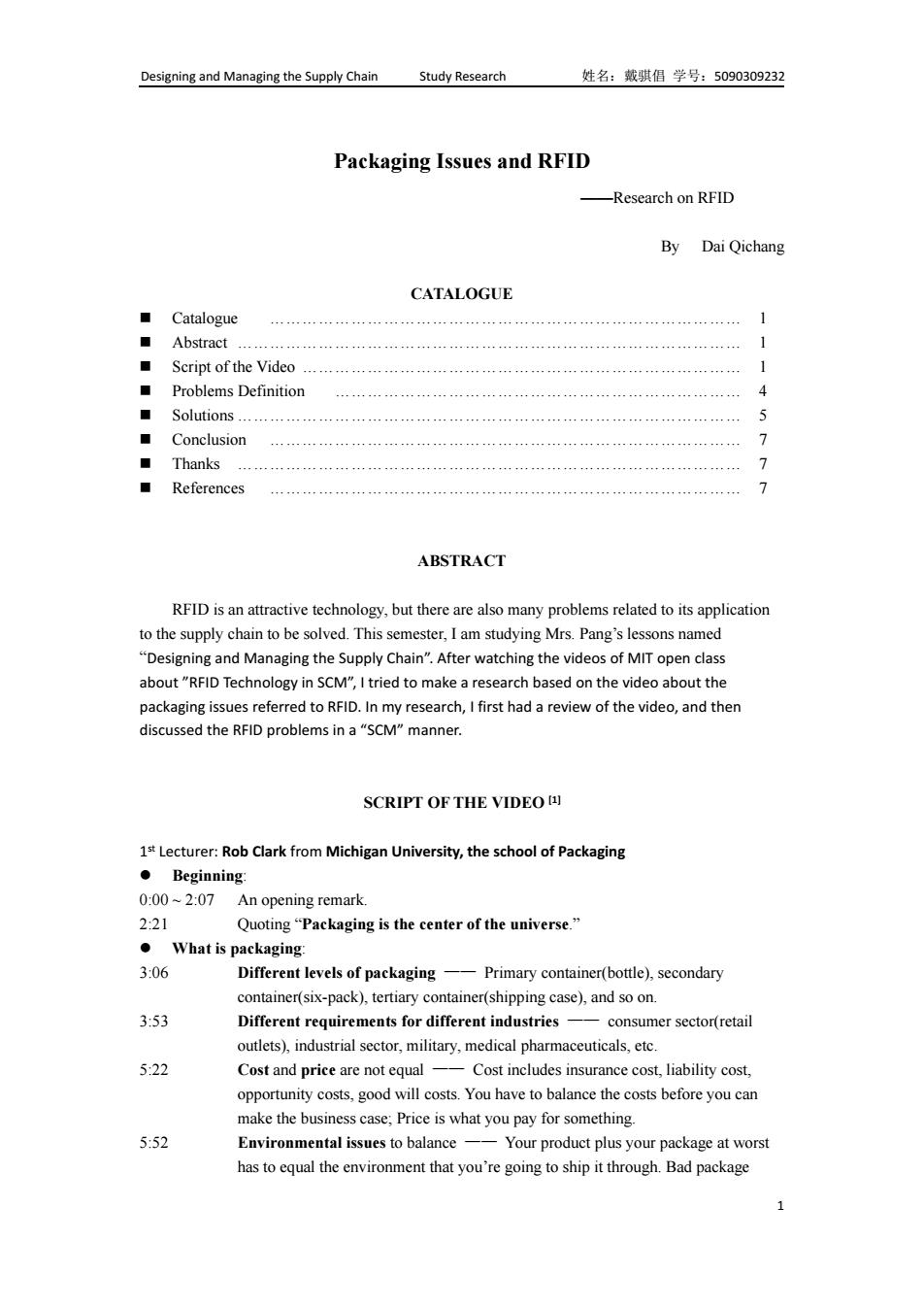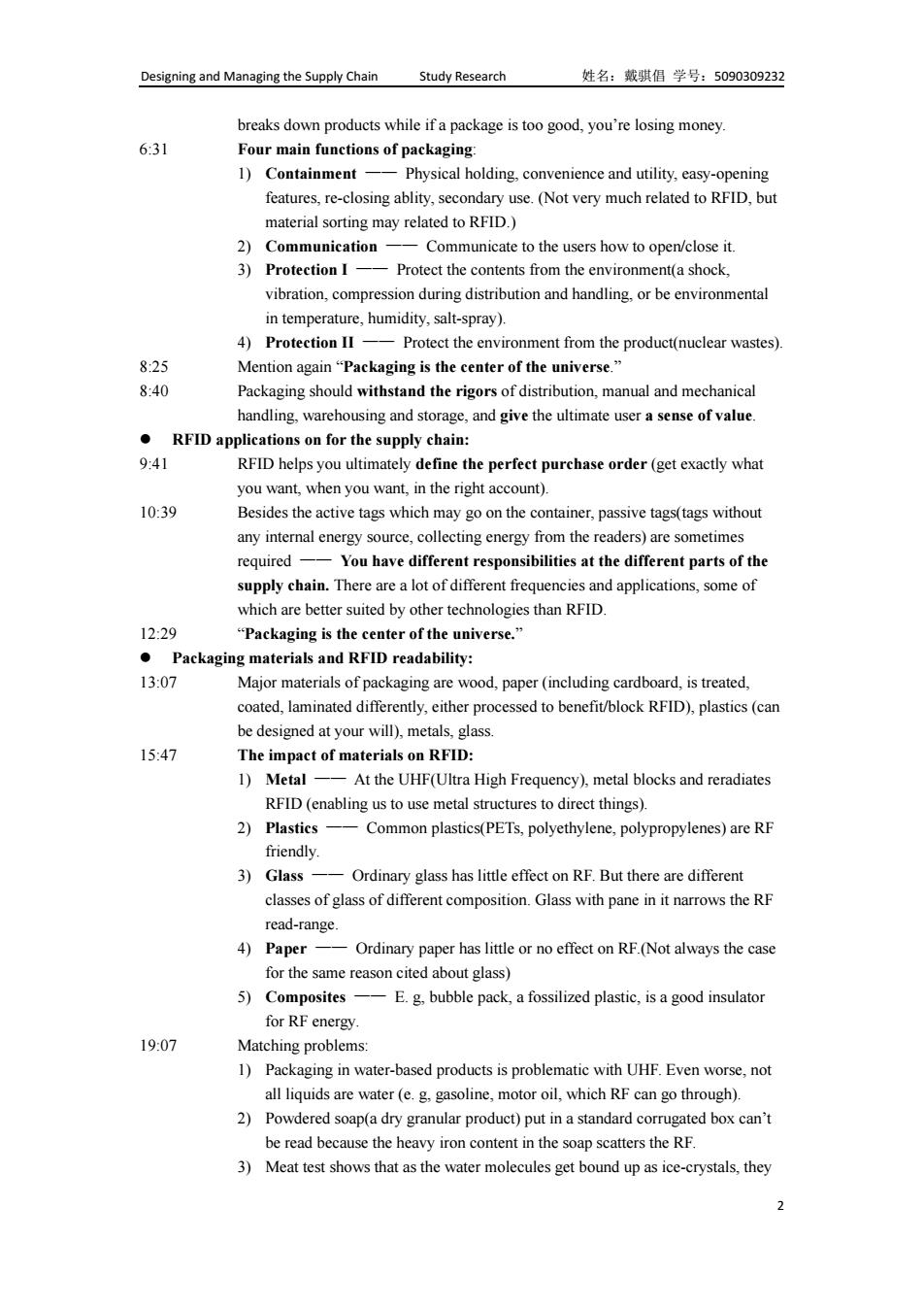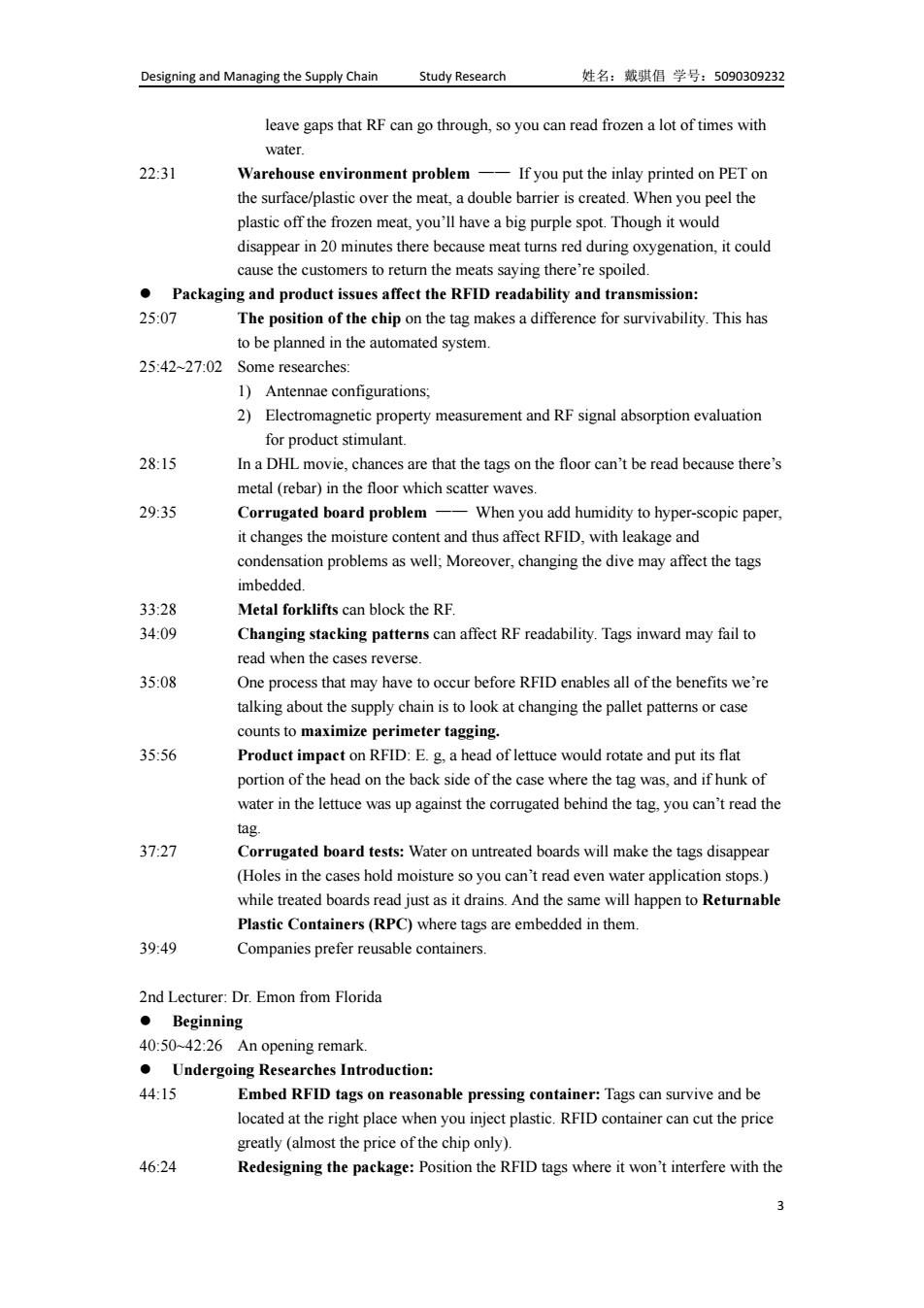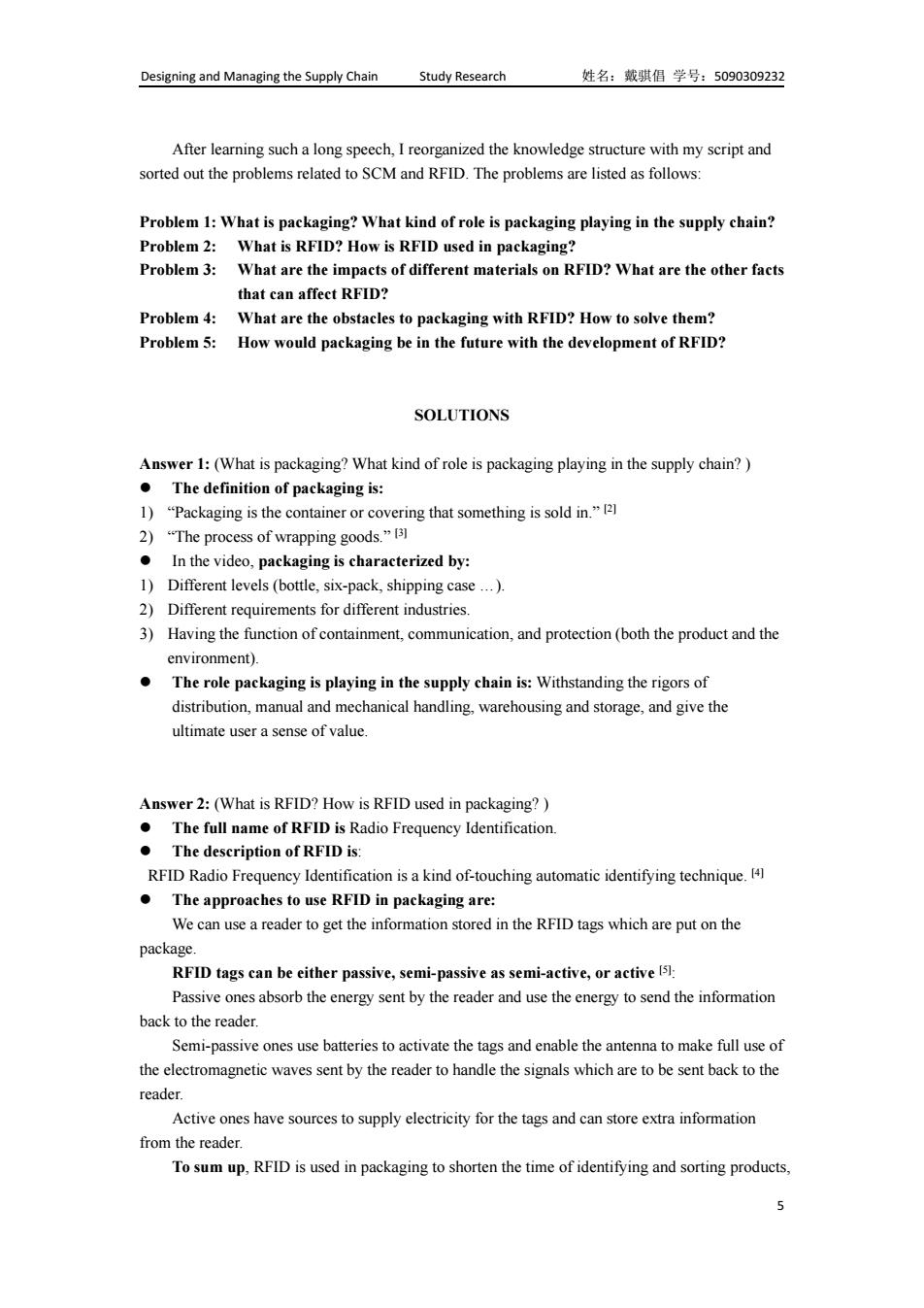
Designing and Managing the Supply Chain Study Research 姓名:戴骐倡学号:5090309232 Packaging Issues and RFID -Research on RFID By Dai Qichang CATALOGUE Catalogue ………………………………………………………… 1 ■ Abstract 1 ■ Script of the Video...…… ■ Problems Definition 4 Solutions 5 ■ Conclusion > ■Thanks 个 References ABSTRACT RFID is an attractive technology,but there are also many problems related to its application to the supply chain to be solved.This semester,I am studying Mrs.Pang's lessons named "Designing and Managing the Supply Chain".After watching the videos of MIT open class about "RFID Technology in SCM",I tried to make a research based on the video about the packaging issues referred to RFID.In my research,I first had a review of the video,and then discussed the RFID problems in a"SCM"manner. SCRIPT OF THE VIDEO 1st Lecturer:Rob Clark from Michigan University,the school of Packaging ●Beginning: 000≈2:07 An opening remark. 2:21 Quoting "Packaging is the center of the universe." ●What is packaging: 3:06 Different levels of packaging-Primary container(bottle),secondary container(six-pack),tertiary container(shipping case),and so on. 3:53 Different requirements for different industries-consumer sector(retail outlets),industrial sector,military,medical pharmaceuticals,etc. 5:22 Cost and price are not equal -Cost includes insurance cost,liability cost, opportunity costs,good will costs.You have to balance the costs before you can make the business case;Price is what you pay for something. 5:52 Environmental issues to balance --Your product plus your package at worst has to equal the environment that you're going to ship it through.Bad package 1
Designing and Managing the Supply Chain Study Research 姓名:戴骐倡 学号:5090309232 1 Packaging Issues and RFID——Research on RFID By Dai Qichang CATALOGUE Catalogue …………………………………………………………………………… 1 Abstract ………………………………………………………………………………… 1 Script of the Video ……………………………………………………………………… 1 Problems Definition ………………………………………………………………… 4 Solutions ………………………………………………………………………………… 5 Conclusion …………………………………………………………………………… 7 Thanks ………………………………………………………………………………… 7 References …………………………………………………………………………… 7 ABSTRACT RFID is an attractive technology, but there are also many problems related to its application to the supply chain to be solved. This semester, I am studying Mrs. Pang’s lessons named “Designing and Managing the Supply Chain”. After watching the videos of MIT open class about ”RFID Technology in SCM”, I tried to make a research based on the video about the packaging issues referred to RFID. In my research, I first had a review of the video, and then discussed the RFID problems in a “SCM” manner. SCRIPT OF THE VIDEO [1] 1 st Lecturer: Rob Clark from Michigan University, the school of Packaging Beginning: 0:00 ~ 2:07 An opening remark. 2:21 Quoting “Packaging is the center of the universe.” What is packaging: 3:06 Different levels of packaging —— Primary container(bottle), secondary container(six-pack), tertiary container(shipping case), and so on. 3:53 Different requirements for different industries —— consumer sector(retail outlets), industrial sector, military, medical pharmaceuticals, etc. 5:22 Cost and price are not equal —— Cost includes insurance cost, liability cost, opportunity costs, good will costs. You have to balance the costs before you can make the business case; Price is what you pay for something. 5:52 Environmental issues to balance —— Your product plus your package at worst has to equal the environment that you’re going to ship it through. Bad package

Designing and Managing the Supply Chain Study Research 姓名:戴骐倡学号:5090309232 breaks down products while if a package is too good,you're losing money. 631 Four main functions of packaging: 1)Containment -Physical holding,convenience and utility,easy-opening features,re-closing ablity,secondary use.(Not very much related to RFID,but material sorting may related to RFID.) 2)Communication-Communicate to the users how to open/close it. 3)Protection I--Protect the contents from the environment(a shock, vibration,compression during distribution and handling,or be environmental in temperature,humidity,salt-spray). 4)Protection II-Protect the environment from the product(nuclear wastes). 8:25 Mention again "Packaging is the center of the universe." 8:40 Packaging should withstand the rigors of distribution,manual and mechanical handling,warehousing and storage,and give the ultimate user a sense of value. RFID applications on for the supply chain: 9:41 RFID helps you ultimately define the perfect purchase order(get exactly what you want,when you want,in the right account). 10:39 Besides the active tags which may go on the container,passive tags(tags without any internal energy source,collecting energy from the readers)are sometimes required--You have different responsibilities at the different parts of the supply chain.There are a lot of different frequencies and applications,some of which are better suited by other technologies than RFID. 12:29 "Packaging is the center of the universe." Packaging materials and RFID readability: 13:07 Major materials of packaging are wood,paper(including cardboard,is treated, coated,laminated differently,either processed to benefit/block RFID),plastics(can be designed at your will).metals.glass. 15:47 The impact of materials on RFID: 1)Metal -At the UHF(Ultra High Frequency),metal blocks and reradiates RFID(enabling us to use metal structures to direct things). 2)Plastics -Common plastics(PETs,polyethylene,polypropylenes)are RF friendly. 3)Glass-Ordinary glass has little effect on RF.But there are different classes of glass of different composition.Glass with pane in it narrows the RF read-range. 4)Paper -Ordinary paper has little or no effect on RF.(Not always the case for the same reason cited about glass) 5)Composites--E.g,bubble pack,a fossilized plastic,is a good insulator for RF energy. 19:07 Matching problems: 1)Packaging in water-based products is problematic with UHF.Even worse,not all liquids are water(e.g,gasoline,motor oil,which RF can go through). 2)Powdered soap(a dry granular product)put in a standard corrugated box can't be read because the heavy iron content in the soap scatters the RF. 3)Meat test shows that as the water molecules get bound up as ice-crystals,they 2
Designing and Managing the Supply Chain Study Research 姓名:戴骐倡 学号:5090309232 2 breaks down products while if a package is too good, you’re losing money. 6:31 Four main functions of packaging: 1) Containment —— Physical holding, convenience and utility, easy-opening features, re-closing ablity, secondary use. (Not very much related to RFID, but material sorting may related to RFID.) 2) Communication —— Communicate to the users how to open/close it. 3) Protection I —— Protect the contents from the environment(a shock, vibration, compression during distribution and handling, or be environmental in temperature, humidity, salt-spray). 4) Protection II —— Protect the environment from the product(nuclear wastes). 8:25 Mention again “Packaging is the center of the universe.” 8:40 Packaging should withstand the rigors of distribution, manual and mechanical handling, warehousing and storage, and give the ultimate user a sense of value. RFID applications on for the supply chain: 9:41 RFID helps you ultimately define the perfect purchase order (get exactly what you want, when you want, in the right account). 10:39 Besides the active tags which may go on the container, passive tags(tags without any internal energy source, collecting energy from the readers) are sometimes required —— You have different responsibilities at the different parts of the supply chain. There are a lot of different frequencies and applications, some of which are better suited by other technologies than RFID. 12:29 “Packaging is the center of the universe.” Packaging materials and RFID readability: 13:07 Major materials of packaging are wood, paper (including cardboard, is treated, coated, laminated differently, either processed to benefit/block RFID), plastics (can be designed at your will), metals, glass. 15:47 The impact of materials on RFID: 1) Metal —— At the UHF(Ultra High Frequency), metal blocks and reradiates RFID (enabling us to use metal structures to direct things). 2) Plastics —— Common plastics(PETs, polyethylene, polypropylenes) are RF friendly. 3) Glass —— Ordinary glass has little effect on RF. But there are different classes of glass of different composition. Glass with pane in it narrows the RF read-range. 4) Paper —— Ordinary paper has little or no effect on RF.(Not always the case for the same reason cited about glass) 5) Composites —— E. g, bubble pack, a fossilized plastic, is a good insulator for RF energy. 19:07 Matching problems: 1) Packaging in water-based products is problematic with UHF. Even worse, not all liquids are water (e. g, gasoline, motor oil, which RF can go through). 2) Powdered soap(a dry granular product) put in a standard corrugated box can’t be read because the heavy iron content in the soap scatters the RF. 3) Meat test shows that as the water molecules get bound up as ice-crystals, they

Designing and Managing the Supply Chain Study Research 姓名:戴骐倡学号:5090309232 leave gaps that RF can go through,so you can read frozen a lot of times with water. 22:31 Warehouse environment problem--If you put the inlay printed on PET on the surface/plastic over the meat,a double barrier is created.When you peel the plastic off the frozen meat,you'll have a big purple spot.Though it would disappear in 20 minutes there because meat turns red during oxygenation,it could cause the customers to return the meats saying there're spoiled. Packaging and product issues affect the RFID readability and transmission: 25:07 The position of the chip on the tag makes a difference for survivability.This has to be planned in the automated system. 25:42~27:02 Some researches: 1)Antennae configurations; 2)Electromagnetic property measurement and RF signal absorption evaluation for product stimulant. 28:15 In a DHL movie,chances are that the tags on the floor can't be read because there's metal(rebar)in the floor which scatter waves. 29:35 Corrugated board problem -When you add humidity to hyper-scopic paper, it changes the moisture content and thus affect RFID,with leakage and condensation problems as well;Moreover,changing the dive may affect the tags imbedded. 33:28 Metal forklifts can block the RF 34:09 Changing stacking patterns can affect RF readability.Tags inward may fail to read when the cases reverse. 35:08 One process that may have to occur before RFID enables all of the benefits we're talking about the supply chain is to look at changing the pallet patterns or case counts to maximize perimeter tagging. 35:56 Product impact on RFID:E.g,a head of lettuce would rotate and put its flat portion of the head on the back side of the case where the tag was,and if hunk of water in the lettuce was up against the corrugated behind the tag,you can't read the tag. 37:27 Corrugated board tests:Water on untreated boards will make the tags disappear (Holes in the cases hold moisture so you can't read even water application stops.) while treated boards read just as it drains.And the same will happen to Returnable Plastic Containers(RPC)where tags are embedded in them. 39:49 Companies prefer reusable containers. 2nd Lecturer:Dr.Emon from Florida ● Beginning 40:50-42:26 An opening remark. Undergoing Researches Introduction: 44:15 Embed RFID tags on reasonable pressing container:Tags can survive and be located at the right place when you inject plastic.RFID container can cut the price greatly (almost the price of the chip only). 46:24 Redesigning the package:Position the RFID tags where it won't interfere with the
Designing and Managing the Supply Chain Study Research 姓名:戴骐倡 学号:5090309232 3 leave gaps that RF can go through, so you can read frozen a lot of times with water. 22:31 Warehouse environment problem —— If you put the inlay printed on PET on the surface/plastic over the meat, a double barrier is created. When you peel the plastic off the frozen meat, you’ll have a big purple spot. Though it would disappear in 20 minutes there because meat turns red during oxygenation, it could cause the customers to return the meats saying there’re spoiled. Packaging and product issues affect the RFID readability and transmission: 25:07 The position of the chip on the tag makes a difference for survivability. This has to be planned in the automated system. 25:42~27:02 Some researches: 1) Antennae configurations; 2) Electromagnetic property measurement and RF signal absorption evaluation for product stimulant. 28:15 In a DHL movie, chances are that the tags on the floor can’t be read because there’s metal (rebar) in the floor which scatter waves. 29:35 Corrugated board problem —— When you add humidity to hyper-scopic paper, it changes the moisture content and thus affect RFID, with leakage and condensation problems as well; Moreover, changing the dive may affect the tags imbedded. 33:28 Metal forklifts can block the RF. 34:09 Changing stacking patterns can affect RF readability. Tags inward may fail to read when the cases reverse. 35:08 One process that may have to occur before RFID enables all of the benefits we’re talking about the supply chain is to look at changing the pallet patterns or case counts to maximize perimeter tagging. 35:56 Product impact on RFID: E. g, a head of lettuce would rotate and put its flat portion of the head on the back side of the case where the tag was, and if hunk of water in the lettuce was up against the corrugated behind the tag, you can’t read the tag. 37:27 Corrugated board tests: Water on untreated boards will make the tags disappear (Holes in the cases hold moisture so you can’t read even water application stops.) while treated boards read just as it drains. And the same will happen to Returnable Plastic Containers (RPC) where tags are embedded in them. 39:49 Companies prefer reusable containers. 2nd Lecturer: Dr. Emon from Florida Beginning 40:50~42:26 An opening remark. Undergoing Researches Introduction: 44:15 Embed RFID tags on reasonable pressing container: Tags can survive and be located at the right place when you inject plastic. RFID container can cut the price greatly (almost the price of the chip only). 46:24 Redesigning the package: Position the RFID tags where it won’t interfere with the

Designing and Managing the Supply Chain Study Research 姓名:戴骐倡学号:5090309232 products and get a good read. 3rd Lecturer:John Pierre,from Mead West Bay.Co. ●Beginning: 48:38~49:04 An opening remark. Consumer products packaging issues: 49:22 Three prime areas of the company.The first is the media and entertainment 49:36 Out of stock problem-Customer who find the title out of stock in the store will go to some other store. 50:06 Counterfeits issue --The FDA strongly suggests RFID in the package 50:27 The second area is the consumer and office products area. 50:57 A group called Intelligence Systems in the company came up with the an intelligence shelf system,reducing the cost by using only one reader to read 100 antenna and having a single wire running down the antenna. 53:56 Referred to Organic RFID and chip-less tags. 55:38 The total cost of the tag over the lifetime Chip price +Price to put a tag on the package +antennae cost crossover cost(cost for failed reads). 56:28 The last area is the whole area of track and trace. 57:0067:20Q&A. ●Q&A: Q1:What changes are you seeing as you're experiment with RFID technology in your packaging design? Rob:I don't see much new at all.The units are the same that I used to study random vibration as an energy source. RF is not a discipline but just an adaptive technology that helps. Q2:The FDA has asked to secure around counterfeiting that there is overt,covert and forensic.And I'm not seeing it in forensic. Rob:I don't have a really good answer on the forensic. Q3:How is RFID starting to work its way into the curriculum particularly the undergraduates and also how are you training the guys? Rob:From a Michigan State stand point,I started teaching a class on RFID and packaging 2 years ago and it's been an elective class,but it's had really good turn outs not only from packaging but from engineering,from supply chain management,logistics and other crossover areas.We are developing an online web-based program for recent graduates Emon:We have subjects on tracks of distribution,packaging,customer product,etc,all having a chapter where it's suitable to put RFID inside. John:Basically,we have been talking to our senior management about it for probably 6 years. Q4:As a member of EPC global,we'd like more academic involvement in standardizing how to measure the metric,how dodo make that happen? Rob:We want to work in conjunction with you on developing these and share the data. Emon:In our lab,we touch many areas and some of them fall on what EPC is looking for.But we still are going to keep looking other areas because the request for the application is pretty big. PROBLEMS DEFINITION 4
Designing and Managing the Supply Chain Study Research 姓名:戴骐倡 学号:5090309232 4 products and get a good read. 3rd Lecturer: John Pierre, from Mead West Bay. Co. Beginning: 48:38~49:04 An opening remark. Consumer products packaging issues : 49:22 Three prime areas of the company. The first is the media and entertainment. 49:36 Out of stock problem —— Customer who find the title out of stock in the store will go to some other store. 50:06 Counterfeits issue —— The FDA strongly suggests RFID in the package. 50:27 The second area is the consumer and office products area. 50:57 A group called Intelligence Systems in the company came up with the an intelligence shelf system, reducing the cost by using only one reader to read 100 antenna and having a single wire running down the antenna. 53:56 Referred to Organic RFID and chip-less tags. 55:38 The total cost of the tag over the lifetime = Chip price + Price to put a tag on the package + antennae cost + crossover cost (cost for failed reads). 56:28 The last area is the whole area of track and trace. 57:00~67:20 Q&A. Q&A: Q1: What changes are you seeing as you’re experiment with RFID technology in your packaging design? Rob: I don’t see much new at all. The units are the same that I used to study random vibration as an energy source. RF is not a discipline but just an adaptive technology that helps. Q2: The FDA has asked to secure around counterfeiting that there is overt, covert and forensic. And I’m not seeing it in forensic. Rob: I don’t have a really good answer on the forensic. Q3: How is RFID starting to work its way into the curriculum particularly the undergraduates and also how are you training the guys? Rob: From a Michigan State stand point, I started teaching a class on RFID and packaging 2 years ago and it’s been an elective class, but it’s had really good turn outs not only from packaging but from engineering, from supply chain management, logistics and other crossover areas. We are developing an online web-based program for recent graduates. Emon: We have subjects on tracks of distribution, packaging, customer product, etc, all having a chapter where it’s suitable to put RFID inside. John: Basically, we have been talking to our senior management about it for probably 6 years. Q4: As a member of EPC global, we’d like more academic involvement in standardizing how to measure the metric, how do do make that happen? Rob: We want to work in conjunction with you on developing these and share the data. Emon: In our lab, we touch many areas and some of them fall on what EPC is looking for. But we still are going to keep looking other areas because the request for the application is pretty big. PROBLEMS DEFINITION

Designing and Managing the Supply Chain Study Research 姓名:戴骐倡学号:5090309232 After learning such a long speech,I reorganized the knowledge structure with my script and sorted out the problems related to SCM and RFID.The problems are listed as follows: Problem 1:What is packaging?What kind of role is packaging playing in the supply chain? Problem 2:What is RFID?How is RFID used in packaging? Problem 3:What are the impacts of different materials on RFID?What are the other facts that can affect RFID? Problem 4:What are the obstacles to packaging with RFID?How to solve them? Problem 5:How would packaging be in the future with the development of RFID? SOLUTIONS Answer 1:(What is packaging?What kind of role is packaging playing in the supply chain?) The definition of packaging is: 1)"Packaging is the container or covering that something is sold in."12 2)“The process of wrapping goods.”Bl In the video,packaging is characterized by: 1)Different levels(bottle,six-pack,shipping case...). 2)Different requirements for different industries. 3)Having the function of containment,communication,and protection(both the product and the environment). ● The role packaging is playing in the supply chain is:Withstanding the rigors of distribution,manual and mechanical handling,warehousing and storage,and give the ultimate user a sense of value. Answer 2:(What is RFID?How is RFID used in packaging? The full name of RFID is Radio Frequency Identification. The description of RFID is: RFID Radio Frequency Identification is a kind of-touching automatic identifying technique.4 The approaches to use RFID in packaging are: We can use a reader to get the information stored in the RFID tags which are put on the package. RFID tags can be either passive,semi-passive as semi-active,or active (51: Passive ones absorb the energy sent by the reader and use the energy to send the information back to the reader. Semi-passive ones use batteries to activate the tags and enable the antenna to make full use of the electromagnetic waves sent by the reader to handle the signals which are to be sent back to the reader. Active ones have sources to supply electricity for the tags and can store extra information from the reader. To sum up,RFID is used in packaging to shorten the time of identifying and sorting products, 5
Designing and Managing the Supply Chain Study Research 姓名:戴骐倡 学号:5090309232 5 After learning such a long speech, I reorganized the knowledge structure with my script and sorted out the problems related to SCM and RFID. The problems are listed as follows: Problem 1: What is packaging? What kind of role is packaging playing in the supply chain? Problem 2: What is RFID? How is RFID used in packaging? Problem 3: What are the impacts of different materials on RFID? What are the other facts that can affect RFID? Problem 4: What are the obstacles to packaging with RFID? How to solve them? Problem 5: How would packaging be in the future with the development of RFID? SOLUTIONS Answer 1: (What is packaging? What kind of role is packaging playing in the supply chain? ) The definition of packaging is: 1) “Packaging is the container or covering that something is sold in.” [2] 2) “The process of wrapping goods.” [3] In the video, packaging is characterized by: 1) Different levels (bottle, six-pack, shipping case …). 2) Different requirements for different industries. 3) Having the function of containment, communication, and protection (both the product and the environment). The role packaging is playing in the supply chain is: Withstanding the rigors of distribution, manual and mechanical handling, warehousing and storage, and give the ultimate user a sense of value. Answer 2: (What is RFID? How is RFID used in packaging? ) The full name of RFID is Radio Frequency Identification. The description of RFID is: RFID Radio Frequency Identification is a kind of-touching automatic identifying technique. [4] The approaches to use RFID in packaging are: We can use a reader to get the information stored in the RFID tags which are put on the package. RFID tags can be either passive, semi-passive as semi-active, or active [5]: Passive ones absorb the energy sent by the reader and use the energy to send the information back to the reader. Semi-passive ones use batteries to activate the tags and enable the antenna to make full use of the electromagnetic waves sent by the reader to handle the signals which are to be sent back to the reader. Active ones have sources to supply electricity for the tags and can store extra information from the reader. To sum up, RFID is used in packaging to shorten the time of identifying and sorting products